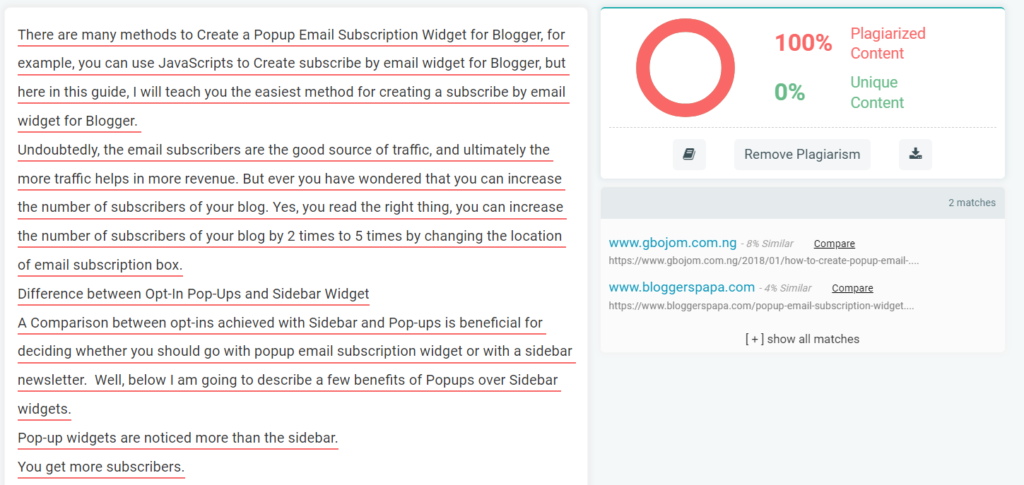5 Tips to Check and Remove Plagiarism from Your Content. In content writing, some pitfalls should be avoided at all costs. One such pitfall is plagiarism. Plagiarism is an unethical act in which a person uses the work of another person without crediting them and claims that it was his/hers, to begin with.
Naturally, this blatant stealing of content is not tolerated by society. In the modern day, detecting plagiarism is as easy as pie. Search engines can automatically determine whether the content on a website is unique or not.
In the latter case, that website gets its SERPs (Search Engine Results Pages) ranking reduced or it is completely delisted.
Furthermore, readers who find plagiarized content are more than capable of determining whether they have read something before or not.
Once they realize that the content is rehashed, they simply leave the page and that can result in an increased bounce rate. A high bounce rate is another factor that contributes to rank reduction.
By now you should have some idea why plagiarism is bad and should be avoided in content writing. So, let’s take a look at five tips that can help you do so.
5 Tips to Check and Remove Plagiarism from Your Content
Here are five tips to check and remove plagiarism. Here is the list of 5 Tips to Check and Remove Plagiarism from Your Content:
1. Utilize Plagiarism Checkers
The most obvious step that content writers can take is to use plagiarism-checking tools to check their work for plagiarism. These tools are freely available on the internet as browser tools or as mobile applications.
You can utilize a plagiarism checker to check articles that are 1,000 words long. Some tools have higher limits and allow you to check even 2,000 words. This is more than enough to check a standard blog post as they are usually 700 to 1,500 words long.

Plagiarism-checking tools are really useful because they not only detect if some work has been plagiarized, but they also show the percentage of plagiarism as well as provide links to the sources whose content has been plagiarized.
And not only that but the parts that are copied are underlined or highlighted so that you know exactly where to start editing.
Due to the assistance from these tools, rooting out plagiarism from the content becomes very easy. If you forgot to cite a source, then you can cite it using the link provided by the tool, or you can simply remove the plagiarized text altogether.
2. Exploit Paraphrasing
Paraphrasing is an important skill to have for writers. Content writers are especially in need of it because they have to write on practically the same thing multiple times over a month or several months.
This means they have to resort to paraphrasing to keep the content fresh. Manual paraphrasing is not the only way; however, there are online tools available known as paraphrasing tools that can do that as well. Paraphrasing is used to remove plagiarism in content if it’s too late to rewrite the entire article.
Basically, if an article is completely written and plagiarism is found in it during proofreading, then the duplicated part is simply paraphrase to make it different from the original and not count as plagiarism.

This method of using them is so common that a lot of online tools have started putting in specialized modes that are labelled “plagiarism remover” or something similar. With paraphrasing small instances of plagiarism can be removed easily.
3. Maintain a References List
References are necessary when you are writing something that is based on the work of others. All authors’ work that you use to prove points in your own content needs to be referenced accordingly.
A common mistake that writers make is that they leave all the referencing for last. What happens is that they lost track of what ideas or data they got from which document.
This leads them to mistakenly believe that some idea was theirs, to begin with, or they credit the wrong author accidentally.
As we know both of those things are considered plagiarism. Hence, to avoid such an outcome in the first place, it is a good idea to maintain a list of references which contains the names of the sources, their authors, and what ideas/data you took from it.
That way when you are citing everything at the end, you will know what came from where and have no problems with accidental plagiarism.
4. Collect Information from Many Documents
Plagiarism can sneak into your work in many ways. One way in which that happens is when writers research their topics using a few sources only.
This means that they get a very biased view on the topic and can unconsciously channel that into their own writing.
This results in you having mirrored/echoed the same ideas and thoughts as the author of the source. And that is part of plagiarism. The only way to avoid this kind of plagiarism is to get information from many documents.
When you read from many sources, you get to see different perspectives and viewpoints. Consequently, the knowledge you get is unbiased and comparatively more objective.
With an unbiased viewpoint, you have more freedom to express your thoughts on the matter and as such, there will be little to no plagiarism in your work.
5. Citations and Quotes
When writing technical or academic content, it is a necessity to provide citations as evidence for your claims or observations.
When you cite somebody’s work, you are crediting them for it and that does not count as plagiarism. So, when writing such content, you should always include a bibliography at the end of the text which lists all the works you have cited.
Not only that, you must provide in-line citations where you use the text. Otherwise, the readers will not know which part of the text is credited to whom.
Quotes should also be used wherever you feel that the original author has better wording than you. They are also used when providing definitions or facts. Quotes also need to be cited in line after the inverted commas are closed.
Their entry also needs to be entered in the bibliography. Keep in mind that only one type of citation format should be followed throughout the document.
If you change styles then that will count as an incorrect citation which is considered plagiarism.
Conclusion
With these five tips, you can effectively detect and avoid plagiarism in your content. Any time you have to write something, practice these tips and with time they will become second nature.
Plagiarism needs to be avoided not only because of its consequences such as loss of reputation and inability to further a literary/academic career but also due to its inherent criminal nature.
Plagiarism is theft and fraud combined into one, while there may be no punishments such as jail time; fines and monetary remuneration can be demanded by the affected parties.



